Impact of nutrient imbalance on wine alcoholic fermentations: nitrogen excess enhances yeast cell death in lipid-limited must
- PMID: 23658613
- PMCID: PMC3637302
- DOI: 10.1371/journal.pone.0061645
Impact of nutrient imbalance on wine alcoholic fermentations: nitrogen excess enhances yeast cell death in lipid-limited must
Abstract
We evaluated the consequences of nutritional imbalances, particularly lipid/nitrogen imbalances, on wine yeast survival during alcoholic fermentation. We report that lipid limitation (ergosterol limitation in our model) led to a rapid loss of viability during the stationary phase of fermentation and that the cell death rate is strongly modulated by nitrogen availability and nature. Yeast survival was reduced in the presence of excess nitrogen in lipid-limited fermentations. The rapidly dying yeast cells in fermentations in high nitrogen and lipid-limited conditions displayed a lower storage of the carbohydrates trehalose and glycogen than observed in nitrogen-limited cells. We studied the cell stress response using HSP12 promoter-driven GFP expression as a marker, and found that lipid limitation triggered a weaker stress response than nitrogen limitation. We used a SCH9-deleted strain to assess the involvement of nitrogen signalling pathways in the triggering of cell death. Deletion of SCH9 increased yeast viability in the presence of excess nitrogen, indicating that a signalling pathway acting through Sch9p is involved in this nitrogen-triggered cell death. We also show that various nitrogen sources, but not histidine or proline, provoked cell death. Our various findings indicate that lipid limitation does not elicit a transcriptional programme that leads to a stress response protecting yeast cells and that nitrogen excess triggers cell death by modulating this stress response, but not through HSP12. These results reveal a possibly negative role of nitrogen in fermentation, with reported effects referring to ergosterol limitation conditions. These effects should be taken into account in the management of alcoholic fermentations.
Conflict of interest statement
Figures
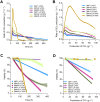

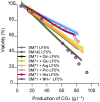

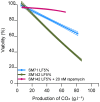
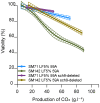
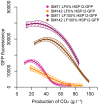
Similar articles
-
A set of nutrient limitations trigger yeast cell death in a nitrogen-dependent manner during wine alcoholic fermentation.PLoS One. 2017 Sep 18;12(9):e0184838. doi: 10.1371/journal.pone.0184838. eCollection 2017. PLoS One. 2017. PMID: 28922393 Free PMC article.
-
Optogenetic control of horizontally acquired genes prevent stuck fermentations in yeast.Microbiol Spectr. 2025 Feb 4;13(2):e0179424. doi: 10.1128/spectrum.01794-24. Epub 2025 Jan 8. Microbiol Spectr. 2025. PMID: 39772912 Free PMC article.
-
Genome-wide monitoring of wine yeast gene expression during alcoholic fermentation.Yeast. 2003 Dec;20(16):1369-85. doi: 10.1002/yea.1046. Yeast. 2003. PMID: 14663829
-
Responses of Saccharomyces cerevisiae to nitrogen starvation in wine alcoholic fermentation.Appl Microbiol Biotechnol. 2015 Sep;99(17):7025-34. doi: 10.1007/s00253-015-6810-z. Epub 2015 Jul 23. Appl Microbiol Biotechnol. 2015. PMID: 26201494 Review.
-
Influence of nitrogen status in wine alcoholic fermentation.Food Microbiol. 2019 Oct;83:71-85. doi: 10.1016/j.fm.2019.04.008. Epub 2019 Apr 23. Food Microbiol. 2019. PMID: 31202421 Review.
Cited by
-
Interplay among Gcn5, Sch9 and mitochondria during chronological aging of wine yeast is dependent on growth conditions.PLoS One. 2015 Feb 6;10(2):e0117267. doi: 10.1371/journal.pone.0117267. eCollection 2015. PLoS One. 2015. PMID: 25658705 Free PMC article.
-
Enhancing yeast growth with carboxylates under multiple nutrient limitations.3 Biotech. 2021 Sep;11(9):409. doi: 10.1007/s13205-021-02955-w. Epub 2021 Aug 14. 3 Biotech. 2021. PMID: 34471591 Free PMC article.
-
A set of nutrient limitations trigger yeast cell death in a nitrogen-dependent manner during wine alcoholic fermentation.PLoS One. 2017 Sep 18;12(9):e0184838. doi: 10.1371/journal.pone.0184838. eCollection 2017. PLoS One. 2017. PMID: 28922393 Free PMC article.
-
Deciphering regulatory variation of THI genes in alcoholic fermentation indicate an impact of Thi3p on PDC1 expression.BMC Genomics. 2014 Dec 10;15(1):1085. doi: 10.1186/1471-2164-15-1085. BMC Genomics. 2014. PMID: 25494835 Free PMC article.
-
Yeast Creates a Niche for Symbiotic Lactic Acid Bacteria through Nitrogen Overflow.Cell Syst. 2017 Oct 25;5(4):345-357.e6. doi: 10.1016/j.cels.2017.09.002. Epub 2017 Sep 27. Cell Syst. 2017. PMID: 28964698 Free PMC article.
References
-
- Agenbach WA (1977) A study of must nitrogen content in relation to incomplete fermentations, yeast production and fermentation activity. In: Proceedings South African Society of Enology and Viticulture, Cape Town, South Africa Stellenbosh SA: pp. 66–87.
-
- Cramer AC, Vlassides S, Block DE (2002) Kinetic model for nitrogen-limited wine fermentations. Biotechnol Bioeng 77: 49–60. - PubMed
-
- Bely M, Sablayrolles JM, Barre PO (1990) Automatic detection of assimilable nitrogen deficiencies during alcoholic fermentation in oenological conditions. J Ferm Bioen 70: 246–252.
-
- Fornairon-Bonnefond C, Demaretz V, Rosenfeld E, Salmon JM (2002) Oxygen addition and sterol synthesis in Saccharomyces cerevisiae during enological fermentation. J Biosci Bioeng 93: 176–182. - PubMed
-
- Zara G, Angelozz D, Belviso S, Bardi L, Goffrini P, et al. (2009) Oxygen is required to restore flor strain viability and lipid biosynthesis under fermentative conditions. FEMS Yeast Res 9: 217–225. - PubMed
Publication types
MeSH terms
Substances
LinkOut - more resources
Full Text Sources
Other Literature Sources
Molecular Biology Databases

